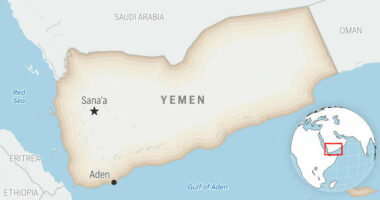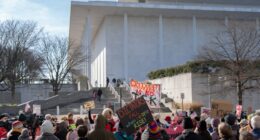Share this @internewscast.com

CHOEUNG EK – On Tuesday, approximately 2,000 people gathered to commemorate Cambodia’s annual Day of Remembrance, marking fifty years since the outbreak of the Khmer Rouge’s brutal regime. This four-year period of horror led to the deaths of around 1.7 million Cambodians.
Roughly three dozen students from an art school in Phnom Penh presented a reenactment of the atrocities committed by the Khmer Rouge, who ruled from 1975 to 1979. It was a period in which roughly a quarter of Cambodia’s population perished due to torture, executions, famine, and poor governance.
The official ceremony, which paid tribute to the victims of what a U.N.-assisted tribunal concluded was genocide, took place at Choeung Ek. This site, known as a Khmer Rouge “Killing Field,” is located approximately 15 kilometers (10 miles) south of Phnom Penh. The event was attended by several dozen Buddhist monks.
Garbed in black, the Khmer Rouge’s standard attire, the performers acted as executioners, swinging bamboo sticks at the heads of victims whose arms were bound behind their backs. The re-enactment was held near a memorial displaying victims’ skulls and mass graves where thousands of others were buried.
“When I come here, it reminded me, and I will never forget, this Khmer Rouge regime because it was extremely cruel and barbaric,” said 71-year-old Nhem Sovann, a Phnom Penh resident who said she lost six family members — her parents-in-law and two brothers and two sisters. She was put to work faming a rice field in the western province of Pursat.
“I saw with my own eyes that even children were taken and had their heads smashed against the trunk of a coconut tree,” she said, sobbing.
For a younger generation, the “Day of Remembrance” is a learning experience.
Pen Kunthea, a 23-year-old art student who portrayed a government soldier who rescued fellow Cambodians from the Khmer Rouge as they were being chased from power in early 1979, said the more she performs, the more she learns.
She said she first learned about the Khmer Rouge regime from her parents and from her studies, and that one of her uncles died from illness during the Khmer Rouge’s time in power.
“I feel scared, and I think the Khmer Rouge made our people afraid and I don’t want that regime to happen again,” Pen Kunthea said.
“When I perform, it makes me feel like I was in the middle of the story,” she said, adding that she was excited to be able to portray the history of the regime.
The Khmer Rouge captured Phnom Penh on April 17, 1975 and immediately herded almost all the city’s residents into the countryside, where they were forced to toll in harsh conditions until in 1979, when the regime was driven from power by an invasion from neighboring Vietnam.
In 1984, a new Cambodian government installed by the Vietnamese declared May 20, the day the genocide was said to begin, to be a “National Day of Hatred” for people to vent their anger against the Khmer Rouge and its backers.
At the time the Khmer Rouge were still trying to regain power by fighting a guerrilla war from the countryside, only to be finally subdued in 1997.
In 2018, the day was officially redesignated the National Day of Remembrance, with an emphasis on honoring the victims.
In a statement issued Tuesday, Prime Minister Hun Manet urged all Cambodians join in preserving and protecting peace.
“Even though these tragic events have passed, and the Cambodian people have been living in peace, political stability, and full of development in all fields, we must not let go or forget this bitter past,” he said.
Copyright 2025 The Associated Press. All rights reserved. This material may not be published, broadcast, rewritten or redistributed without permission.














